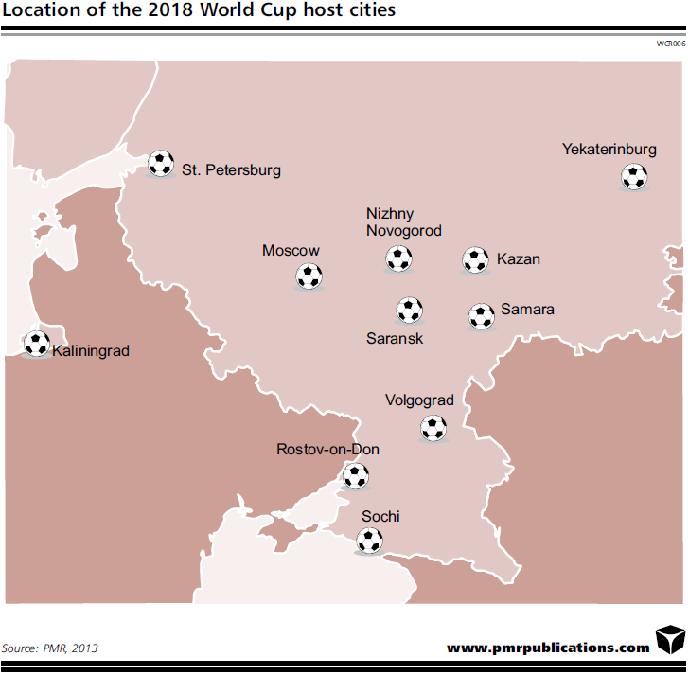As indicated by the results of PMR’s latest report, entitled “World Cup 2018 in Russia – Construction investments”, in the next five years at least RUB 664bn ($21bn) will be spent from the federal and regional coffers as well as by private investors under preparation for the 2018 FIFA World Cup
Initially, officials of host cities submitted projects to be developed under preparation for the tournament with a total value of about RUB 1,390bn ($43bn). Half of this amount is to be provided by the Government of the Russian Federation and one third by private investors. It should be mentioned that this value does not cover investment in the construction of stadiums in Kazan, Sochi and Spartak Stadium (Otkritie Arena) in Moscow. Furthermore, it only includes a minor share of transport infrastructure construction projects that are to be implemented in host cities by mid-2018. The new stadium in Kazan was put into use in July 2013. The stadium in Sochi is to be built by January 2014 and Spartak Stadium by May 2014. Most transport infrastructure construction projects are being implemented within a dedicated targeted programme: Development of Russia’s Transport System 2010-2020.
According to PMR, it is a huge challenge for Russian officials to develop nine stadiums by the end of 2017. The construction of Zenit Stadium in St. Petersburg is expected to be completed no earlier than Q4 2015, even though the project was launched in 2007. The reconstruction of Luzhniki Stadium in Moscow and Tsentralny Stadium in Yekaterinburg will start in 2014, at best. In 2014 there are plans to initiate the construction of new 45,000-seaters in Kaliningrad, Rostov-on-Don, Volgograd, Nizhny Novgorod, Samara and Saransk. Even though the construction of a new stadium in Saransk was commenced in 2010, little progress has been achieved. Only the initial stage of construction has been completed, with the areas beneath the stands also having seen some development.
With regard to hospitality facilities, individual cities differ widely in accommodation opportunities. In all the 2018 World Cup host cities (except Saransk) there is a sufficient number of beds for official guests. However, some of the host cities do not have enough beds to accommodate fans. Among the cities hosting the 2018 World Cup, Moscow and St. Petersburg are the largest contributors, while Kaliningrad and Saransk have the lowest ratio of hotel beds available. Under current macroeconomic conditions, private investors are expected to be more reticent in setting up new projects in regional cities. Investors have to consider how new facilities will be used after the tournament, as the occupancy rate in many host cities is currently far from levels that encourage the development of new projects.
Russian transportation infrastructure prepared for the 2018 World Cup will be constructed and modernised on a large scale. By the time of the tournament, the motorway connecting Moscow and St. Petersburg will have to have been constructed, and the Don, Ukraine, Ural, Kaspiy, Volga and Russia federal highways will need to have been fully modernised. Between 2013 and 2018, the Russian Federation and private investors are planning to allocate RUB 1,137bn ($36bn) on the construction, reconstruction and modernisation of ten key highways that will be mostly used by visitors travelling between the World Cup 2018 host cities. According to Rosavtodor, about 40% of the country’s federal roads met regulatory compliance requirements at the end of 2012. Furthermore, only 37% of Russia’s regional road network complied, according to the Russian Association of Regional Road Administrations (RADOR).
Large projects will be also rolled out in the railway construction segment. It is beyond a doubt that the most expensive railway construction projects to have been implemented in Russia by 2020 will be the expansion of the Baykal-Amur Main Line and Trans-Siberian railway lines. These two projects combined are expected to need as much as RUB 769bn ($24bn). Even though there are plans to build in the coming years the 803 km Moscow-Kazan high-speed railway with a total investment of about RUB 928bn ($29bn), lack of funding is expected to keep the project in the planning phase at least until 2016. Important funding will also be provided for the development of the Moscow railway hub, into which there are plans to pump at least RUB 237bn ($7.4bn) by 2020. To successfully implement its development programme, Russian Railways aims to roll out expensive projects in cooperation with private investors. Investors will be invited to get involved in the construction of 31 transport junction-type hubs at intersections of the Moscow Rail Ring Road with Moscow metro stations, bus stations and train network stations on radial rail lines. According to preliminary estimates, the development of all 31 hubs will involve the construction of 250,000 m² of technological space and 500,000-700,000 m² of commercial real estate, requiring an estimated investment of about RUB 60bn ($1.9bn).
According to PMR estimates, during 2013-2018 the aggregate capital expenditure to be incurred on the 13 Russian airports handling passengers attending the 2018 World Cup will total nearly RUB 193bn ($6bn), of which the projects planned in Moscow, St. Petersburg and Rostov-on-Don are the most costly. In Moscow investments might come to RUB 112.5bn ($3.5bn) and reach RUB 31.4 ($1bn) in Rostov-on-Don. Between 2013 and 2018, Saransk and Kazan airports will be the slowest in implementing airport construction projects. Kazan will be in this position as it has been extensively modernised in recent years under preparations for the 2013 Summer Universiade. As for Saransk, the city is too small (just 300,000 people) for a large airport hub. Besides, it is located close to other major airports: Kurumoch Airport in Samara, Strigino Airport in Nizhny Novgorod and Kazan International Airport.
Source: PMR
 Constructionshows
Constructionshows
